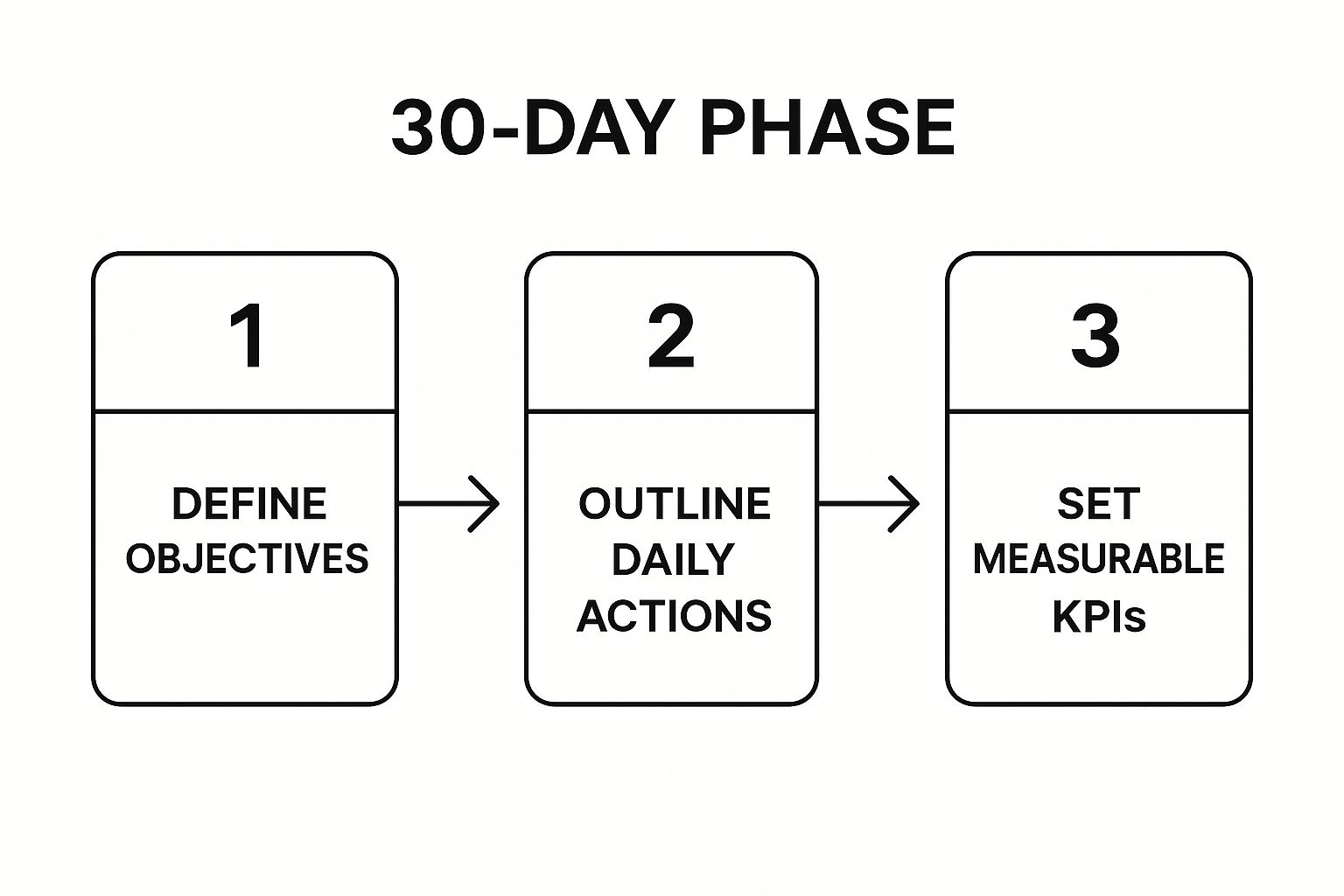Ever heard of a 30-60-90 day plan? It’s far more than just a fancy to-do list for a new job. Think of it as your personal roadmap for the first three months—a strategic document that shows you mean business from the moment you walk in the door. It lays out your priorities, your goals, and tells your new manager you’re proactive and ready to align with the company's vision.
Why Your First 90 Days Matter So Much

Starting a new role can feel a bit like landing in a foreign country. Suddenly, you're navigating a new culture, a new language full of acronyms, and a whole new cast of characters. It’s a make-or-break period. Those first 90 days are when first impressions solidify and the foundation for your future success gets poured. Without a clear plan, it's easy to get swamped by the onboarding whirlwind.
This is where a solid 30-60-90 day plan comes in. It cuts through the chaos and turns a period of potential uncertainty into one of focused, intentional action. It’s also a brilliant communication tool that proves to your manager you're organised, strategic, and serious about contributing.
This plan is your first chance to manage up. Instead of passively waiting for tasks, you’re presenting a thoughtful strategy that kicks off a conversation about what success actually looks like for you.
The Strategic Advantage of a Plan
From the company's side, a structured plan like this is quickly becoming essential. In competitive markets, a 30-60-90 day plan is viewed as a critical tool for getting new hires up to speed. For example, some Silicon Valley startups found that reps with these plans hit productivity milestones 25% faster than those with a less structured onboarding experience.
This isn’t just about looking good; it's about delivering real results. A well-thought-out plan helps you:
- Hit the Right Targets: It ensures your energy is aimed squarely at the company's most important goals.
- Secure Early Wins: You can pinpoint low-hanging fruit to deliver value quickly, which builds immediate trust and credibility.
- Gain Crystal Clarity: It transforms a broad job description into a clear, step-by-step agenda for each 30-day block.
- Track Your Impact: You define how you’ll measure your progress, making it easy to show the value you’re bringing.
For field sales teams, this kind of structure is non-negotiable. A new rep can use their plan to map out territories, get a handle on lead sources, and become a pro with their sales tools. Planning the first 90 days allows them to move methodically from learning the ropes to confidently closing deals.
To see how the right tools can supercharge this process, check out our guide on getting started with LeadFlow Manager. It’s the perfect companion to your plan, helping you hit the ground running from day one.
Your First 30 Days: Become a Sponge

The biggest mistake I see new hires make? They try to change the company in their first month. Right now, that’s not your job. Your primary mission is simple: listen, learn, and absorb everything you possibly can.
Think of yourself as a sponge. You're there to soak up the company culture, figure out who the key players are, and learn the unwritten rules of the office. This first part of your 30-60-90 day plan is all about building a foundation. Trust me, jumping into action without knowing the lay of the land is a fast track to making a costly misstep.
Prioritise People and Relationships
Your first order of business should be connecting with people. You have a very short window where the "I'm new here" card works, giving you a free pass to ask questions about absolutely everything. Start by asking your manager for a list of must-meet people.
Then, let that list grow organically. After every chat, ask one simple but incredibly effective question: "Who else do you think I should talk to?" This is how you start to piece together the real organisational chart, not just the one on paper.
- Meet your immediate team: Get to know their roles, what they’re working on, and what their biggest headaches are.
- Connect with cross-functional partners: If you’re in sales, talk to the marketing team. If you’re in marketing, find the product managers. Understanding how the departments interact is crucial.
- Talk to leadership: Try to get a few minutes with senior leaders to hear their high-level vision for the company and where they see your role fitting in.
Decode the Business and Its Metrics
While you're building those relationships, your other main objective is to get under the hood of the business itself. You need a rock-solid grasp of the key performance indicators (KPIs) that actually define success in your role and for your team.
For a field sales rep using a tool like LeadFlow Manager, this goes way beyond just knowing your quota. It’s about digging into the lead sources, understanding conversion rates territory by territory, and knowing the average sales cycle down to the day. These details are the language the business speaks.
Don’t just accept the metrics you're given. Ask why they matter. Understanding the story behind the numbers gives you a much richer picture of the company’s real priorities and challenges.
Real-World Example: A Marketing Manager's First 30 Days
Let's imagine a new marketing manager joining a company with a dedicated field sales team. The first month of her 30-60-90 day plan isn't about launching a flashy new campaign. Instead, she’s in full-on sponge mode.
Here’s what her first few weeks might look like:
- Week 1: She has one-on-ones with every single sales rep. She wants to know their best lead sources and their biggest frustrations with the current marketing support.
- Week 2: She gets access to the company’s LeadFlow Manager account and dives deep into the historical data, looking at campaign performance and lead-to-close rates.
- Week 3: She schedules meetings with the head of sales and the key product managers to understand what their priorities are for the upcoming quarter.
- Week 4: She puts together a "State of the Union" summary for marketing, mapping out existing campaigns, key stakeholder relationships, and the performance metrics that matter most.
By the end of the month, has she changed anything? No. But what she has is far more valuable: a complete, 360-degree view of the landscape. She knows who to talk to, what success looks like, and where the biggest opportunities are. That groundwork is what will make the next 60 days of her plan both realistic and incredibly effective.
Days 31 to 60: Time to Make Your Mark

Alright, the first month was all about soaking things in. Now it’s time to take everything you’ve learned and start making a real impact. You've got a feel for the people, the processes, and the priorities. This second phase is where you shift from the passenger seat and get behind the wheel.
Your 30-60-90 day plan should now be focused on active contribution and delivering your first tangible results.
This doesn't mean you have to single-handedly reinvent a department. Far from it. The real goal here is to identify and nail a few "quick wins." These are the small but visible contributions that build trust with your team, prove your value, and show your manager you can turn knowledge into action.
From Shadowing to Leading the Charge
This middle phase is when the real work begins. For a field sales rep, this is a huge transition. You probably spent the first 30 days riding along with senior reps, getting the hang of the pitch, and learning the ins and outs of tools like LeadFlow Manager. Now, the training wheels are coming off.
So what does this look like in practice? Your goals for days 31-60 might include:
- Leading your first sales meetings: You’re no longer just observing. It's your turn to take the lead in customer conversations.
- Owning a small pipeline: Get your hands dirty by managing a specific group of leads from first contact to follow-up, tracking every move in your CRM.
- Suggesting a territory tweak: Maybe you’ve spotted a more efficient sales route using the data you've gathered. Proposing a small adjustment shows you're thinking strategically.
This is the most hands-on part of your 30-60-90 day plan—it’s where you prove you can do the job. The trick is to start with manageable tasks that have a clear, positive outcome. Don't try to boil the ocean. Taking on a massive, complex project right now is a surefire way to get swamped.
The best way to build momentum is by creating visible progress. A quick win isn't just about the outcome; it's about showing your new team that you're a reliable contributor who can be counted on to get things done.
Get Feedback to Calibrate Your Efforts
As you start executing, getting regular feedback from your manager is absolutely critical. Think of your plan as the map, but their perspective is the compass that keeps you pointed in the right direction. Don't wait around for your formal review—be proactive.
Set up short, informal check-ins to talk about how things are going. This isn't just a reporting session; it’s your chance to fine-tune your approach.
Come prepared with specific questions:
- "I’m planning to focus on re-engaging these five dormant leads next week. Does that line up with our team's current goals?"
- "You listened in on my call yesterday—what's one thing I could do to improve my pitch?"
- "I've noticed a potential bottleneck in how we update lead statuses. Is that something you think is worth looking into?"
This kind of proactive communication pays off in two ways. First, it makes sure your early efforts are actually hitting the mark and adding value where it matters most. Second, it shows you’re coachable, strategic, and genuinely invested in the team’s success.
By the end of day 60, you won't just be participating. You'll be seen as a valued contributor, setting the stage for a powerful final 30 days.
Days 61 to 90: Deliver and Drive Forward
Alright, you’ve made it through the first 60 days. You’ve listened, you’ve learned, and you’ve started to contribute. Now, the final phase of your 30-60-90 day plan is where you really start to make your mark. This is all about shifting from being a participant to being a driver.
Think of it this way: the first two months were your apprenticeship. This last month is where you step up and show you can take the lead. It’s your chance to move from being the new hire to becoming an indispensable part of the team—someone who delivers real, measurable results.
From Contributing to Owning
This is where your focus really narrows in on taking full ownership of projects and initiatives. You’re not just checking off tasks anymore; you’re expected to see the bigger picture, think strategically, and take the initiative.
So, what does that look like in practice? A project manager in this phase isn’t just keeping things on schedule. They are actively:
- Hunting for potential risks on the horizon and putting solid plans in place to deal with them.
- Suggesting smarter ways of working that make the whole team more efficient.
- Stepping up to present project outcomes and key learnings to leadership with confidence.
You're no longer just following the map; you're helping to draw it.

The logic shown here—defining clear objectives, actions, and KPIs—is what gets you to this point. By month three, every action you take should tie directly back to the business goals you've been working toward.
Your goal for this period is simple: become a problem-solver. When a challenge comes up in your area, you want your name to be the first one that pops into your manager's head. That’s how you know you've truly integrated into the team.
To give you a clearer picture of how each phase builds on the last, here's a quick breakdown of the typical focus areas, activities, and KPIs you'd see in a well-structured plan.
30-60-90 Day Plan Focus Areas and KPIs
table block not supported
This table illustrates the natural progression from absorbing information to actively shaping outcomes, which is the entire point of this structured approach.
Consolidate Your Achievements
As you near day 90, it's crucial to take a step back and pull all your accomplishments together. This isn't about patting yourself on the back; it’s about building a clear, data-backed story of the value you've brought to the company.
I always recommend creating a simple summary document that highlights your key wins from each 30-day block. This is incredibly useful for a couple of reasons:
- Your 90-Day Review: You walk into your review with your manager armed with concrete evidence of your performance. It makes the conversation more productive and focused on facts.
- Your Future Roadmap: It helps you—and your manager—see where you've excelled and what skills you should work on next. It's the perfect launchpad for your long-term development.
This isn’t just good for you; it's great for the business. Research from California HR departments shows that companies using detailed 30-60-90 day plans see a 30% reduction in first-quarter employee attrition. They also report up to a 20% increase in early employee satisfaction scores. You can dig deeper into the data behind effective employee plans if you're interested.
By the end of this period, you shouldn't feel new anymore. You should feel like a core part of the engine, equipped with a clear record of your impact and a vision for where you're headed next.
Of course. Here is the rewritten section, crafted to sound like it was written by an experienced human expert, following all your specified requirements.
How to Avoid Common 30-60-90 Day Plan Mistakes
Building a 30-60-90 day plan is a great move. But let’s be honest, a bad one can cause more problems than it solves. I've seen it happen: a plan that's completely out of touch with reality sets the wrong expectations and gets a new hire started on a shaky foundation.
Knowing what not to do is just as important as knowing what to do. Let's walk through the most common pitfalls so your plan actually helps you win, instead of just adding stress.
One of the biggest blunders is creating the plan all by yourself. It’s tempting, I get it. You want to walk in on day one with a polished document that blows your new manager away. The problem? That approach almost always misses the mark.
Without their insight, your priorities can be completely misaligned with what the team—and the business—actually needs. You end up chasing what you think is important, while your manager is wondering why you're ignoring the real fires.
Your 30-60-90 day plan should be a collaborative blueprint, not a solo mission. Bring a solid draft to the table, but frame it as a conversation starter. You want to make sure you’re both pointing your compasses in the same direction.
The Dangers of Being Too Rigid
Another trap I see all the time is a plan that's set in stone. Business moves fast. Priorities shift, a huge project can land on your desk out of nowhere, or a golden opportunity might pop up that wasn't on anyone's radar.
If your plan is a rigid contract, you’re stuck. You either have to stick with an outdated strategy or look like you’re already falling behind on your own goals.
Your plan needs to be a living document. For example, a field sales rep might have planned to spend their first 60 days mapping and optimising their territory routes. But what if a massive industry tradeshow gets announced for month two? The smart play is to pivot and focus on event-based lead generation. A rigid plan doesn't allow for that kind of agility. Adapting to new opportunities is critical in field sales, a theme we explore in our guide on lead routing best practices to boost sales efficiency.
Setting Unrealistic Goals
Finally, please, resist the urge to overpromise. Your excitement to make a killer first impression can easily lead to setting goals that are just plain impossible to hit in 90 days. All this does is set you up to fail and chip away at your credibility before you’ve even had a chance to build it.
Instead of a flashy goal like "double sales in the first quarter," think about something more grounded and impactful. A goal like "identify and implement one process improvement to lift qualified leads by 10%" is not only more realistic but also shows strategic thinking.
A few tips from experience:
- Be Ambitious, but Grounded: Your goals should absolutely stretch you, but they shouldn't break you.
- Focus on Learning First: Especially in the first 30-60 days, prioritize goals centred on learning the people, processes, and products. The big results will follow.
